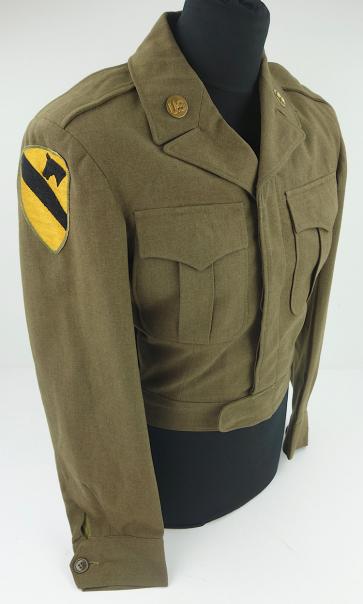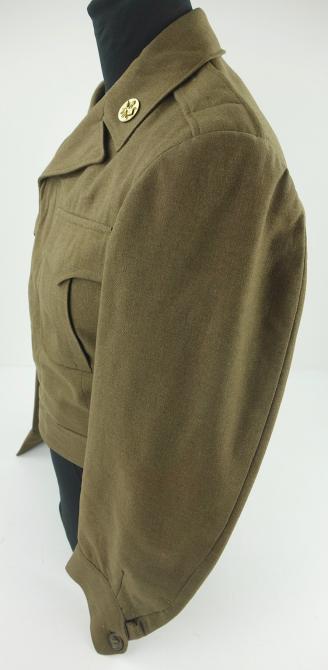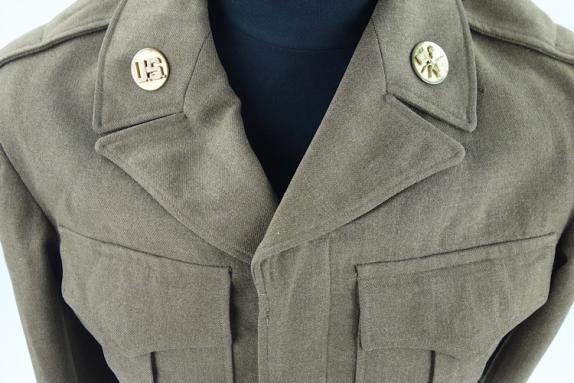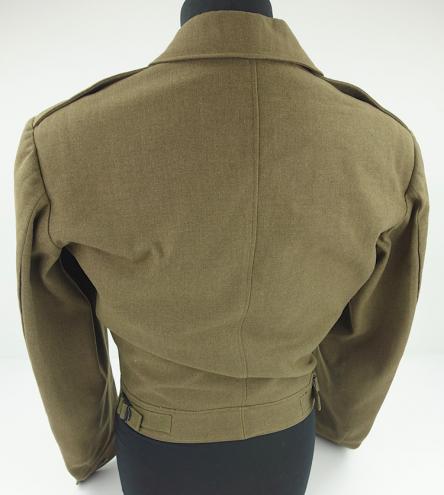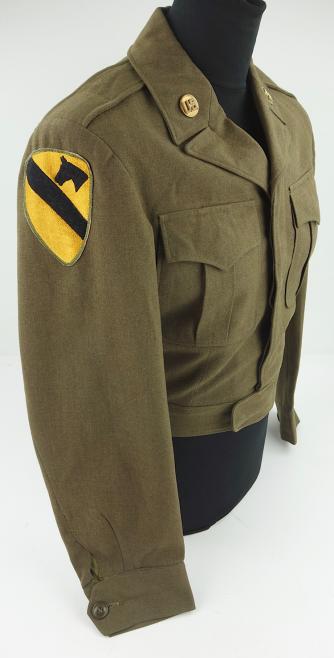US WW2 wool Field Jacket
US WW2 wool Field Jacket
With original patch of the US WW2 1th Cavalry Division.
Nice jacket with original sewed 1th Cavalry Division Patch. With nice oil cloth label, made by “Hoffman Mfg. Co.” Dated “June 2, 1944”
The 1th Cavalry Division saw Action in the pacific!
MANILA, Philippines -- The origins of the 1st Cavalry Division’s motto, “First Team,” can be traced back to World War II and the Battle of Manila from February 3 to March 3, 1945. This year marks the 75th Anniversary of the liberation of the city and the Division’s infamous “flying columns” which led them to be the first in Manila.
Col. Kevin Capra, commander of 3rd Armored Brigade Combat Team, 1st Cavalry Division and Command Sgt. Maj. Ryan McLane along with Lt. Col. Kevin Black, commander of 3rd Battalion, 8th Cavalry Regt. and Command Sgt. Major Scott McLaughlin represented the 1st Cavalry Division during events to honor and remember the awful and bitter fight.
The week-long events began with a symposium where academics, survivors and families discussed the battle, its impact on the population then and now, the war crimes committed by the enemy, Filipino guerilla fighter roles in the battle and much more. Capra gave a talk on the 1st Cavalry Division’s role in the battle.
Capra told how the 1st Calvary Division, after coming ashore in 1945 were directly ordered by Gen. Douglas McArthur to "Go to Manila! Go around the Japanese, bounce off the Japanese, save your men, but get to Manila! Free the internees at Santo Tomas! Take the Malacanan Palace and the legislative building!"
The Division was broken down into three mobile columns mainly made up of a tank company, artillery, engineers, and a medical squadron. They carried only what they needed and, in true cavalry fashion, charged headlong toward Manila. In three days and over 70 miles the column spearheaded by the 8th Cavalry Regt. reached Santo Tomas where 4,000 foreign (mainly American) internees had been held since the fall of the Philippines in 1942.
“Speaking at the symposium about the 1st Cavalry Division and its role in the battle of Manila was phenomenal,” Capra said. “Not just being able to share our story, which many there already knew, but the experience of survivors of Santo Tomas and meeting the families and guerilla fighters themselves was impressive. I think the importance of not losing their stories or ours is what these events over the past week have been about.”
And remembering those stories and making sure the future generations do not forget is what the events of the past week were about according to Cecilia Gaerlan, Founder and Executive Director of Bataan Legacy, a non-profit educational organization based in California. “We need to learn the lessons of war. So now, our mission is kind of diversified it is more focused now on how to engage our young students to become civic-minded so that they learn the lessons of war and will become responsible leaders so something like this never happens again.”
The symposium attracted over 200 attendees including survivors and families of survivors, educators and students from across the Philippines. The presenters shared personal stories, ongoing research and historical narratives all aimed at the one month of death and destruction within the city.
“I’m one of those people who had not studied the Philippines in depth and just understanding how we were fighting and where we were fighting,” Capra said. “I think, learning what I have learned and seeing similarities to even how we fight today just reinforced for me that the character of war changes—the tools and equipment and reasons—but the nature of war stays the same and those are the lessons of the Battle of Manila that we need to remember.”
The battle was only just beginning with the liberation of the internees at Santo Tomas. Over 16,000 Japanese Soldiers and navy personnel had refused to abandon the city to the Americans and dug in forcing the 1st Cavalry and the 37th Infantry Division to root them out street by street. Originally, McArthur had made very restrictive rules of engagements for the city to include no use of artillery or air strikes, but had to change the plan when the Japanese refused to surrender.
The resulting engagements over the next 28 days leveled the city and left thousands of innocent civilians dead. But it was the barbarity of the enemy and their merciless killing of the young, the old, men, women and children that would account for the over 100,000 civilian deaths in Manila.
On Feb. 15th, the Memorare-Manila 1945 Foundation held a memorial ceremony in honor of those killed in the Battle of Manila. Following a wreath laying ceremony at a special monument within the old walled fortress of Intramuros, where a lot of the slaughter occurred, speakers from the US Embassy, the Philippine government and representatives of a Japanese foundation called Friendship Bridge paid respects to the few survivors in attendance as well as those who had died. Among the speakers was Lt. Col. Kevin Black, commander of the 3rd Battalion, 8th Cavalry Regt.
“We cherish the history that our two nations share,” said Black. “It is a history forged through the grit, determination and sacrifice born here 75 years ago on the very ground we stand on.”
According to Desiree Benipayo, vice-president for education for the Philippine World War II Memorial Foundation and Secretary of Memorare-Manila 1945 Foundation, these events are important to maintaining the national identity forged by the sacrifice. The Philippines had only gained its independence following World War II.
“There isn’t one person from Manila or even the Philippines for that matter who have not been touched by what happened in the Battle of Manila. Whether they have a descendant who died or was wounded or captured or lost everything they owned. This is who we are as a people, what defines us and what makes us a strong and this is why we cannot forget.”
In addition to the two events honoring the Battle of Manila, Capra and McLane were able to attend a memorial unveiling in Bagac, in the province of Bataan honoring those who died in the fighting or endured the brutal Bataan Death March. Bagac was the furthest western portion of the final defensive line.
According to Capra, being able to participate in these events and represent the Division were an honor. “The people are great and very welcoming and I think it is extremely important to continue to build upon that foundation and those relationships that have been set over the last 120 years. Events such as this and remembering our shared history will only help to strengthen that bond.”
This marked the first time that the Division participated in memorial events related to the Battle and the organizers hope it isn’t the last.
“Having you here has been amazing. It was a lot of work and figuring out how to invite you and who to go through,” said Benipayo. “But it’s like you’re real. You’re not just a unit number in a history book. There are real Soldiers who carry on the legacy of what the 1st Cavalry Division did for the people of Manila.”
This isn’t the end, nor the beginning, of the commemorations in the Philippines for the end of World War II. Filipinos have been celebrating the liberation of their country since last year with remembrances of the Battle of Leyte Gulf through the landing of General Douglas McArthur and his promised returned three years after evacuating the Island. This was 14 of 82 total events, which will culminate with ceremonies recognizing the official surrender of Japan
Overal a very niece field jacket in very good condition!
Code: 65732



